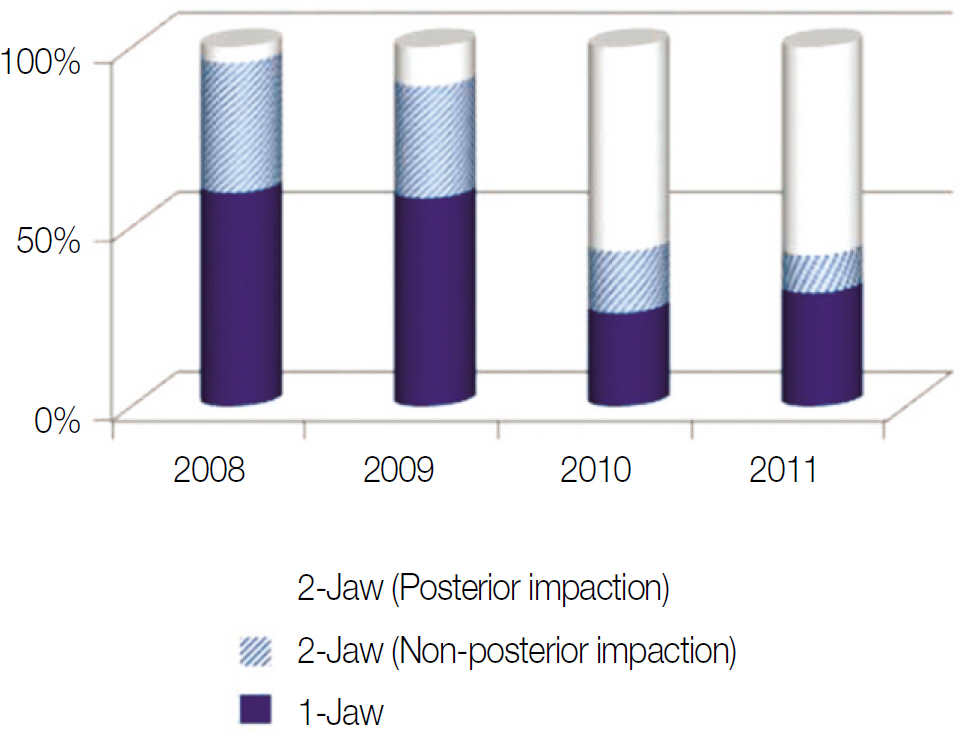J Korean Assoc Oral Maxillofac Surg.
2011 Aug;37(4):264-271. 10.5125/jkaoms.2011.37.4.264.
A comparative study on the change of postoperative facial hard tissue profile after maxillary rotational surgery
- Affiliations
-
- 1Department of Oral and Maxillofacial Surgery, School of Dentistry, Pusan National University, Yangsan, Korea. inkchung@pusan.ac.kr
- KMID: 1449058
- DOI: http://doi.org/10.5125/jkaoms.2011.37.4.264
Abstract
- PURPOSE
This study evaluated retrospectively the postsurgical facial hard tissue profile of a Le Fort I osteotomy with/without posterior impaction and rigid internal fixation to correct mandibular prognathism. After observing a difference between the two groups, this measurement was used to prepare a treatment plan for 2-jaw surgery. Patients and Methods: Thirty patients who had undergone orthognathic surgery in Pusan National University Dental Hospital were enrolled in this study. Fifteen patients were treated using a Le Fort I osteotomy with posterior impaction and mandibular setback bilateral sagittal split ramus osteotomy, and the other fifteen patients were treated without posterior impaction. The preoperative (T0), immediate postoperative (T1) and six-month follow-up period (T2) cephalograms were taken and difference between T1-T0 and T2-T2 was analyzed.
RESULTS
Both groups was FH-ABp, SNB and ANB showed significant changes in the measurement, whereas only the posterior impaction group showed a change in the SN-U1, occlusal plane, posterior facial height, surgical movement difference from the L1 and B-point. There was no significant statistical change between the immediate postoperative (T1) and six-month follow-up (T2) hard tissue analysis in the two groups.
CONCLUSION
A Le Fort I osteotomy with posterior impaction is considerable for patients with a flat occlusal plane angle, large posterior facial height, prominent B-point, pogonion and labioversed incisal inclination if the indications are well chosen.
MeSH Terms
Figure
Reference
-
1. Enacar A, Taner T, Manav O. Effects of single- or double-jaw surgery on vertical dimension in skeletal Class III patients. Int J Adult Orthodon Orthognath Surg. 2001; 16:30–5.2. Reyneke JP, Evans WG. Surgical manipulation of the occlusal plane. Int J Adult Orthodon Orthognath Surg. 1990; 5:99–110.3. Wolford LM, Chemello PD, Hilliard F. Occlusal plane alteration in orthognathic surgery-Part I: Effects on function and esthetics. Am J Orthod Dentofacial Orthop. 1994; 106:304–16.
Article4. Praveen K, Narayanan V, Muthusekhar MR, Baig MF. Hypotensive anesthesia and blood loss in orthognathic surgery: a clinical study. Br J Oral Maxillofac Surg, 2001:39;138-40.5. Chang HH, Ryu SH, Kang JH, Lee SH, Kim JS. Blood loss and hematologic change after orthognathic surgery. J Korean Oral Maxillofac Surg. 2001; 27:435–41.6. Reyneke JP, Bryant RS, Suuronen R, Becher PJ. Postoperative skeletal stability following clockwise and counter-clockwise rotation of the maxillomandibular complex compared to conventional orthognathic treatment. Br J Oral Maxillofac Surg. 2007; 45:56–64.
Article7. Wolford LM, Chemello PD, Hilliard F. Occlusal plane alteration in orthognathic surgery-Part I: Effects on function and esthetics. Am J Orthod Dentofacial Orthop. 1994; 106:304–16.
Article8. Travess HC, Newton JT, Sandy JR, Williams AC. The development of a patient-centered measure of the process and outcome of combined orthodontic and orthognathic treatment. J Orthod. 2004; 31:220–34.
Article9. Cunningham SJ, Garratt AM, Hunt NP. Development of a condition-specific quality of life measure for patients with dentofacial deformity: II. Validity and responsiveness testing. Community Dent Oral Epidemiol. 2002; 30:81–90.
Article10. Burke L, Croucher R. Criteria of good dental practice generated by general dental practitioners and patients. Int Dent J. 1996; 46:3–9.11. Laufer D, Glick D, Gutman D, Sharon A. Patients motivation and response to surgical correction of prognathism. Oral surg Oral Med Oral Pathol. 1976; 41:309–13.12. Jeong MH, Choi JH, Kim BH, Kim SG, Nahm DS. Soft tissue changes after double jaw rotation surgery in skeletal class III malocclusion. J Korean Oral Maxillofac Surg. 2006; 32:559–65.13. Epker BN, Schendel SA. Total maxillary surgery. Int J Oral Surg. 1980; 9:1–24.
Article14. LaBanc JP, Epker BN. Changes of the hyoid bone and tongue following advancement of the mandible. Oral Surg Oral Med Oral Pathol. 1984; 57:351–6.
Article15. Kim BH, et al. Treatment goals and planning in class III 2-jaw surgery-the contribution of jaw rotation. J Korean Foundation for Gnatho-orthodontic research. 2005; 7:39–51.16. Yang SD, Suhr CH. F-H to AB plane angle(FABA) for assessment of anteroposterior jaw relationships. Angle Orthod. 1995; 65:223–31.17. Kim KH, Choy KC, Kim HG, Park KH. Cephalometric Norms of the hard tissues of Korean orthognathic surgery. J Korean Oral Maxillofac Surg. 2001; 27:221–30.18. Holdaway RA. A soft-tissue cephalometric analysis and its use in orthodontic treatment planning. Part I. Am J Orthod. 1983; 84:1–28.
Article
- Full Text Links
- Actions
-
Cited
- CITED
-
- Close
- Share
- Similar articles
-
- A cephalometric study on the changes of soft tissue profile (upper lip and nose) following two-jaw surgery
- Soft Hard Tissue Changes Following Anterior Segmental Sorcery In Bimaxillary Protrusion
- A STUDY ON CHANGE OF THE SOFT TISSUE FACIAL PROFILE AFTER ORTHOGNATHIC SORCERY IN PATIENTS WITH THE MANDIBULAR PROGNATHISM
- Prediction of frontal soft tissue changes after mandibular surgery in facial asymmetry individuals
- Stability And Soft Tissue Changes Following Advancement Le Fort I Osteotomy In The Cleft Lip And Palate Patients




